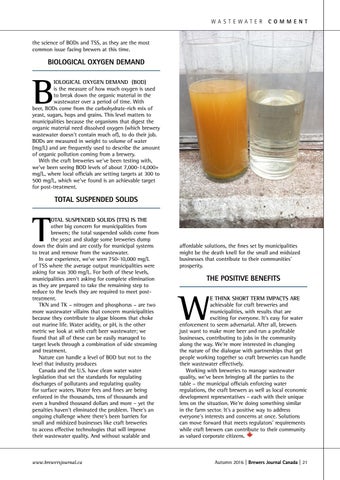W a s t e wat e r
C o m m en t
the science of BODs and TSS, as they are the most common issue facing brewers at this time.
Biological Oxygen demand
B
iological Oxygen Demand (BOD) is the measure of how much oxygen is used to break down the organic material in the wastewater over a period of time. With beer, BODs come from the carbohydrate-rich mix of yeast, sugars, hops and grains. This level matters to municipalities because the organisms that digest the organic material need dissolved oxygen (which brewery wastewater doesn’t contain much of), to do their job. BODs are measured in weight to volume of water (mg/L) and are frequently used to describe the amount of organic pollution coming from a brewery. With the craft breweries we’ve been testing with, we’ve been seeing BOD levels of about 7,000-14,000+ mg/L, where local officials are setting targets at 300 to 500 mg/L, which we’ve found is an achievable target for post-treatment.
total SUspended solids
T
otal Suspended Solids (TTS) is the other big concern for municipalities from brewers; the total suspended solids come from the yeast and sludge some breweries dump down the drain and are costly for municipal systems to treat and remove from the wastewater. In our experience, we’ve seen 750-10,000 mg/L of TSS where the average output municipalities were asking for was 300 mg/L. For both of these levels, municipalities aren’t asking for complete elimination as they are prepared to take the remaining step to reduce to the levels they are required to meet posttreatment. TKN and TK – nitrogen and phosphorus – are two more wastewater villains that concern municipalities because they contribute to algae blooms that choke out marine life. Water acidity, or pH, is the other metric we look at with craft beer wastewater; we found that all of these can be easily managed to target levels through a combination of side streaming and treatment. Nature can handle a level of BOD but not to the level that industry produces Canada and the U.S. have clean water water legislation that set the standards for regulating discharges of pollutants and regulating quality for surface waters. Water fees and fines are being enforced in the thousands, tens of thousands and even a hundred thousand dollars and more – yet the penalties haven’t eliminated the problem. There’s an ongoing challenge where there’s been barriers for small and midsized businesses like craft breweries to access effective technologies that will improve their wastewater quality. And without scalable and
www.brewersjournal.ca
affordable solutions, the fines set by municipalities might be the death knell for the small and midsized businesses that contribute to their communities’ prosperity.
the positive benefits
W
e think short term impacts are achievable for craft breweries and municipalities, with results that are exciting for everyone. It’s easy for water enforcement to seem adversarial. After all, brewers just want to make more beer and run a profitable businesses, contributing to jobs in the community along the way. We’re more interested in changing the nature of the dialogue with partnerships that get people working together so craft breweries can handle their wastewater effectively. Working with breweries to manage wastewater quality, we’ve been bringing all the parties to the table – the municipal officials enforcing water regulations, the craft brewers as well as local economic development representatives – each with their unique lens on the situation. We’re doing something similar in the farm sector. It’s a positive way to address everyone’s interests and concerns at once. Solutions can move forward that meets regulators’ requirements while craft brewers can contribute to their community as valued corporate citizens.
Autumn 2016 | Brewers Journal Canada | 21
